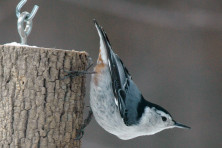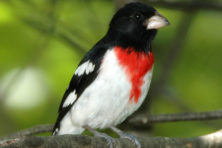Red-Breasted Nuthatch
- Share
- Tweet
- Pin
- Share

Hulled sunflower seeds appeal strongly to the nuthatches. Photo by Roy Lukes.
A few days ago we saw our first Red-breasted Nuthatch of the season at our feeders. It happens every fall as some of them make short migratory movements. If we’re lucky some will find our woods and daily handouts of bird food to their liking and will remain until the following spring. Then they head back to more evergreen woods for nesting, which may even be in our county.
Happy, talkative, jolly, irrepressible, cheery, trusting, quick, agile – from central Canada to southern U.S., bird of the coniferous forest, these nuthatches thrill all who know them.
This diminutive airy bundle of feathers on the move takes to people perhaps as readily as any other wild songbird. Its pleasing nasal “yank yank yank” call, resembling the call one might expect to come from a miniature tin horn, is a part of the music of the boreal forest. At times the song reminds us of the staccato notes of a far-off oboe. Remove the Red-breasted Nuthatch and the northern forest has lost its “pitch pipe.” “Piping Red” keeps the woods and its various creatures in tune.
Should one study the ecology of the northern evergreen forest in depth, surely this agile acrobat would fill an important niche of insect and seed controllers. Many people have seen this nuthatch perched at the top of a spruce tree fly repeatedly into the air in quick short bursts in pursuit of flying insects. Others have observed this bird for hours to find that at times it appears to feed exclusively on the seeds of the Black Spruce.
One interesting observation of their trusting behavior was recorded by an ornithologist onboard a steamer inching its way through a “pea soup” fog along the New England coast in late fall. As so frequently happens, a sizable number of birds, as confused and concerned as may have been the steamer captain, landed aboard ship.
Five Red-breasted nuthatches captivated the passengers with their trusting tameness. One of their favorite eating places was the ship’s wheelhouse where they were able to locate many dead moths along the windowsills which they appeared to relish.

Bathing is often enjoyed by “Piping Red.” Photo by Roy Lukes.
It was my good friend of many years ago, Miss Emma Toft, who taught me how to coax Chickadees and Red-breasted Nuthatches to my opened hand for seeds. I tape recorded her relating stories of her life at Toft Point. One incident she remembered fondly was a Red-breasted Nuthatch bravely feeding from her hand, as if it had no fear of a human.
Every time one of these little creatures has alighted on my hand I’ve gotten the impression that it had big feet in proportion to its tiny body. And talk about being light to the touch. One hardly feels them on the hand. Their toenails are not the least bit sharp, as are woodpeckers’, yet they cling to you with surprising ease.
Unlike its larger White-breasted Nuthatch cousin, the Red-breasted sports a neat black eye stripe, rusty colored flanks and, coupled by its smaller size, moves about with more quickness.
The migration of this little friend of the spruce forest tends to correspond with the status of the cone crop. Mass migrations have been observed in years when, for various reasons, the evergreens produced few cones. Apparently these nuthatches that have been lured into staying in our yard are quite satisfied with the “marvel meal” and black oil sunflower seeds.
Every time we see one of these birds fly away with a surprisingly large sunflower seed, we wonder how it’s going to extract the meat. What it often does is lodge the entire seed in a tiny crevice of bark on the trunk or branch of a tree and then proceed to repeatedly hammer its beak into the meat of the seed. Obviously its name, nuthatch, was derived from “nut-hack.” The word “hatch” in this case is a corruption of “hack.” The English call theirs nuthacks.
Once when given a choice of winter foods composed of various nuts and seeds, this rusty-flanked charmer invariably returns to the pan of black walnuts, as though the other foods didn’t even exist. If you have nuthatches coming to your feeders, better yet to your hand, try some shelled black walnuts. You may be in for a surprise.
Once a pair has mated they will excavate a cavity in which to nest in a rotten tree. They have been known to refuse to use what appeared to be a perfectly suitable nest hole from the previous year, instead starting over from scratch to construct a new one. The point I’m making is, remove the dead rotten trees from the forest and you will automatically remove the Red-breasted Nuthatches too.

Note the stubby tail and upturned beak of this male. Photo by Roy Lukes.
All too often people insist on cleaning up, tidying their forest or woodlot and in so doing completely upset the delicate and important components of a healthy living forest community or ecosystem. Obviously people who do this have no knowledge or appreciation of the life and requirements of a forest. They want to tame it, to reduce it to their standards. They want to “citify” it.
The majority of the understory plants, the herbs and shrubs, are cleared out. All the downed decaying trees are destroyed. Lower limbs of evergreens are removed in order to open up the view of the water or landscape. Kentucky Bluegrass takes the place of native plants. Now the people can boast of a tidy lawn, a huge expanse of solid green, a boring monoculture at best.
Rather than enjoying nature at its finest, they end up spending hours keeping the lawn painfully and expensively manicured, just as was done back in the city. Red-breasted Nuthatches can’t live on Kentucky Bluegrass.
I cite the case of the Red-breasted Nuthatch as just one example of a host of native animals that are being pushed out and displaced to death by people. It’s high time we begin to take a long-range look into the future, 20, 50, 100 years and more, to ensure those people the great joy of having Red-breasted nuthatches feed from their hands too. These birds can’t preserve unspoiled northern forest communities, but people can!


